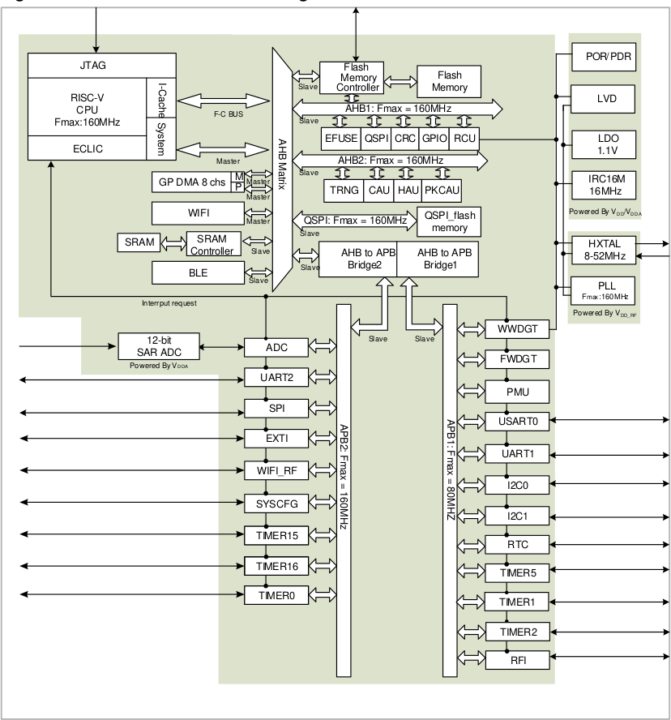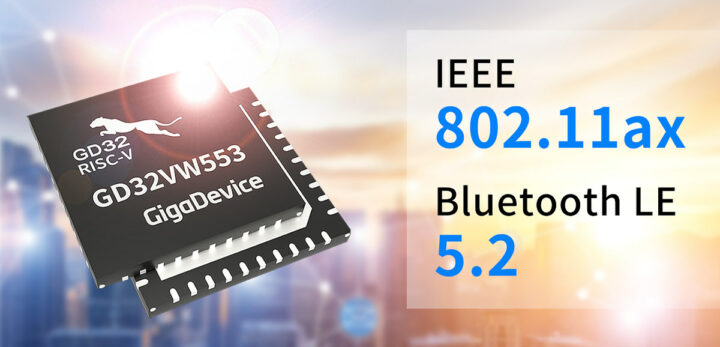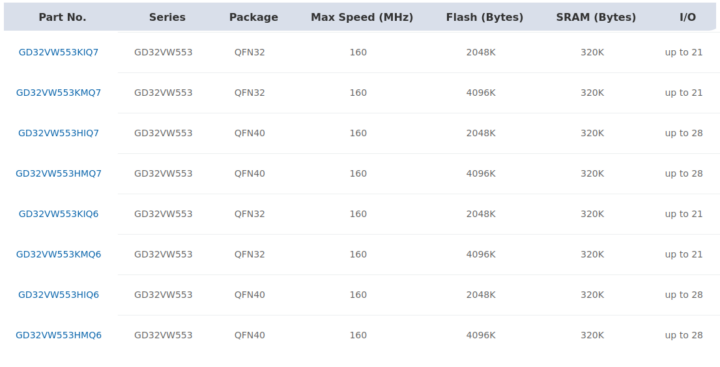Gigadevice GD32VW553 is a new 160MHz RISC-V microcontroller for IoT applications with support for WiFi 6 (802.11ax) and Bluetooth 5.2 Low Energy (LE) and available in QFN32 and QFN40 packages with up to 28 GPIOs.
As an IoT chip, the chip supports various power modes and target wake time (TWT) for low power consumption, as well as WiFi features such as WPA3 and WiFi direct, while the radio can handle Bluetooth 5.2 LE bit rates of up to 2 Mbps and support the Long Range mode.
Gigadevice GD32VW553 specifications:
- MCU core – 32-bit Nuclei N307 RISC-V core @ up to 160 MHz with RV32I / M / A / F / D / C / P / B instruction extensions
- Memory – 320KB SRAM
- Storage – 2048KB or 4096KB flash
- Wireless
- WiFI 6
- 802.11b/g/n/ax HT20 up to 114.7Mbps
- 802.11e QoS Enhancement (WMM).
802.11i (WPA, WPA2, WPA3). Open, shared key, and pair-wise key authentication services. - WiFi WPS
- WiFi Direct
- Target Wake up Time (TWT) support
- Bluetooth 5.2 LE (BLE) with 2 Mbps and Long Range support
- 2.4GHz radio shared between WiFi and Bluetooth
- WiFI 6
- Peripherals
- Up to 21x or 28x GPIOs
- 2x I2C, 1x SPI, 1x QSPI
- Serial – 1x USART, 2x UART
- Analog -1x 12-bit ADC unit with 9x channels
- Timers
- 2x 32-bit general-purpose timers
- 2x 16-bit general-purpose timers
- 1x 16-bit advanced timer
- 1x 16-bit basic timer
- 64-bit SysTick timer
- 2x watchdog timers
- 1x RTC
- Security
- Cryptographic acceleration Unit (CAU)
- Hash acceleration unit (HAU)
- Public Key Cryptographic Acceleration Unit (PKCAU)
- True Random number generator (TRNG)
- Supply Voltage – 1.8 to 3.6V
- Power Consumption at 3.3V
- WiFi Tx
- 802.11b, CCK 1Mbps, Pout = +18dBm – 331 mA
- 802.11ax, HE 20M MCS0, Pout = +18dBm – 316 mA
- 802.11ax, HE 20M MCS9, Pout = +12dBm – 265 mA
- WiFi Rx
- 802.11b, CCK 1Mbps, -90dBm – 99 mA
- 802.11ax, HE 20M MCS0, -75dBm – 101 mA
- 802.11ax, HE 20M MCS9, -60dBm – 107 mA
- WiFi sleep – 37.6mA (MCU running)
- Mild sleep (MCU Power on, PLL off, Clock gated)
- DTIM=1 – 1.4mA
- DTIM=3 – 0.55mA
- DTIM=10 – 0.31Ma
- Hibernation – They don’t know yet somehow…
- WiFi Tx
- Packages – QFN32 or QFN40

GigaDevice provides various development tools for the GD32VW553 microcontroller (and other GD32 MCUs) including the GD32 IDE, the GD-LINK debugging and download tool, and the GD32 All-In-One Programmer. The company also says it has released SDKs with the necessary drivers, wireless protocol stack, and “application routine”. But it’s unclear where to look as the company points to a “development tools” page with evaluation boards and starter kits, but none are based on the GD32VW553 at this time.
The GD32VW553 development board – for which we could not find any information at this time – is supported to work with unnamed Real-Time Operating Systems (RTOS) with local connection, cloud connection, security, and Over the Air (OTA) upgrade, and the kit is said to support Matter over Wi-Fi for Smart Home applications. Finally, an alternative to the GD32 IDE will be the SEGGER Embedded Studio IDE and IAR Embedded Workbench, both of which support the new RISC-V wireless microcontroller.
Eight parts are available, but you may have noticed some parts have the same highlights in the table above, that’s because Q6 devices work in the -40°C to +85°C temperature range, while the Q7 can operate in harsher conditions between -40°C and +105°C. Gigadevice expects the GD32VW553 MCU to be integrated into Smart Home appliances and systems, industrial Internet gateways, and communication gateways, as well as office equipment, payment terminals, and various IoT products.
The GD32VW553 WiFi 6 and Bluetooth 5.2 microcontroller looks quite similar to the ESP32-C6 which also features a RISC-V core clocked at 160 MHz and the same wireless capabilities plus an an extra 802.15.4 radio for Zigbee and Thread. So Gigadevice possibly designed the new chip as an answer to the ESP32-C6 at a cheaper price for application that don’t need an 802.15.4 radio.
GigaDevice says QFN40 and QFN32 samples and evaluation boards are available to companies that request some, and mass production is scheduled to start in December 2023. Further information may be found on the product page and in the press release.
Thanks to TLS for the tip.

Jean-Luc started CNX Software in 2010 as a part-time endeavor, before quitting his job as a software engineering manager, and starting to write daily news, and reviews full time later in 2011.
Support CNX Software! Donate via cryptocurrencies, become a Patron on Patreon, or purchase goods on Amazon or Aliexpress






